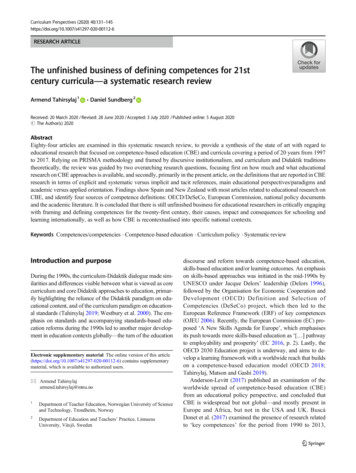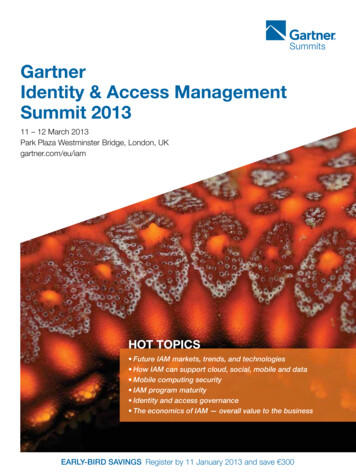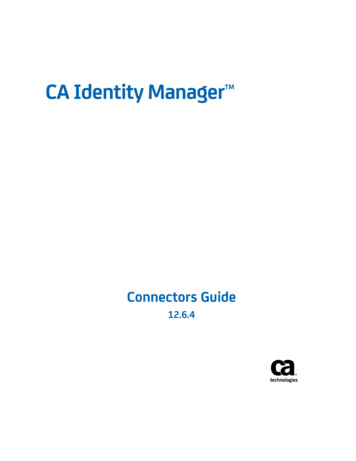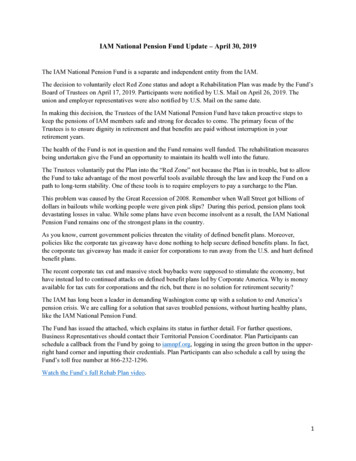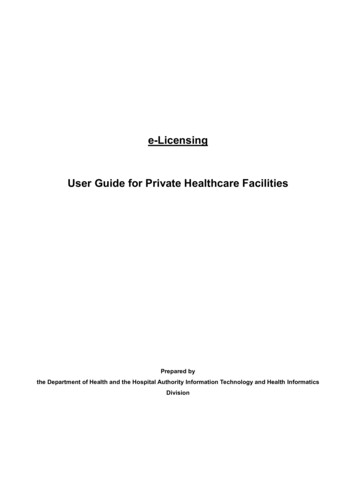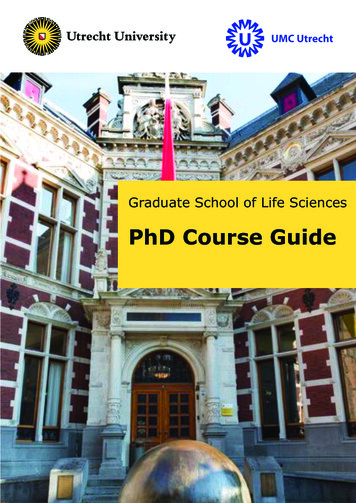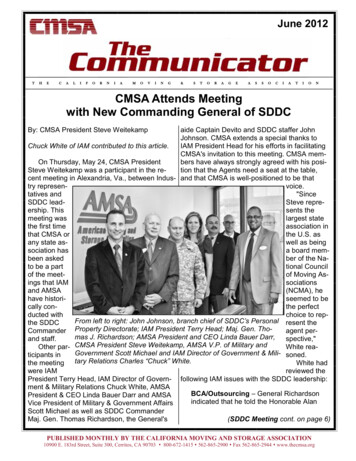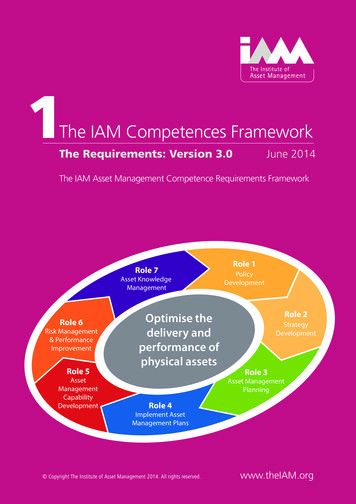
Transcription
1The IAM Competences FrameworkThe Requirements: Version 3.0June 2014The IAM Asset Management Competence Requirements FrameworkRole 7Asset KnowledgeManagementRole 6Risk Management& PerformanceImprovementRole 5AssetManagementCapabilityDevelopmentOptimise thedelivery andperformance ofphysical assetsRole 1PolicyDevelopmentRoleRole 22StrategyStrategyDevelopmentDevelopmentRole 3Asset ManagementPlanningRole 4Implement AssetManagement Plans Copyright The Institute of Asset Management 2014. All rights reserved.www.theIAM.org
The IAM Competences FrameworkPart 1: Asset Management Competence Requirements FrameworkIssue 3.0June 2014Contents1Introduction31.1 Evolution of the Framework31.2 Purposes of the Framework31.3 Guidance and Feedback32Structure of the 2012 Framework43Detailed Contents of the 2012 Framework74Mapping the Competence Framework against the ‘39 subjects’205Importing Units from the 2012 Competence Framework226Steering Group227Bibliography (selected)237.1 IAM Publications237.2 International Publications237.3 Standards Publications237.4 Competence Frameworks237.5 UK Regulatory Authorities238Disclaimer239About the IAM24Publishing and copyright informationThis document is published by the Institute of Asset Management www.theIAM.orgThe IAM copyright notice displayed in this document indicates the date of last revision and issueVersionAmendment VersionDate23.1May 201223.2November 2012Finalising for print andcorrecting typographical errors23.3July 2013Changes made to Figure 2,Page 20 - 212CommentMapped to 39 Subjects(www.theIAM.org/AMA) Copyright The Institute of Asset Management 2014. All rights reserved.
The IAM Competences FrameworkPart 1: Asset Management Competence Requirements FrameworkIssue 3.0June 20141. Introduction1.1Evolution of the FrameworkWhen the Institute of Asset Management (IAM)published its Competency Requirements Frameworkin June 2006, it was a world first. The Frameworkdescribed what people involved in the management ofphysical assets should be able to do and the knowledgeand understanding needed to underpin this.A second version of the Framework was publishedin November 2008. Following user feedback andconsultations, the first version was restructured to makeit less prescriptive and better aligned with BSI: PAS 55:2008 and other leading competence frameworks. Part 1set out a set of generic competence requirements. Part2 contained guidance on how to use the Framework tosupport recruitment, selection, training and developmentand tailor it to meet specific organisational needs.This document contains the third version of the Framework,as updated in June 2014. The 2008 Framework has beenrevised and updated to reflect specific feedback from usersand align it with the latest IAM and international thinkingand developments, as follows: Various amendments and additions have beenmade. The biggest change is the division of Unit 3.3Create and Acquire Assets into two Units, 3.3Produce business case for creating and acquiringassets (which has to do with planning) and Unit4.1 Create and Acquire Assets (which has to dowith implementation). Otherwise, some Elementshave been added and the underpinning knowledgeand understanding requirements have beenenhanced. The requirements set out in the Framework are stillgeneric, applicable to people in asset managementroles in any organisation or sector. Its format isconsistent with that of other leading competenceframeworks and its contents support the principlesand requirements of BSI PAS 55: 2008 and thoseof the ISO 5500x standards which were published inJanuary 2014. Copyright The Institute of Asset Management 2014. All rights reserved. The 2012 Framework is mapped to the 39 subjectsin the Global Forum for Maintenance and AssetManagement (GFMAM) Asset ManagementLandscape (2nd Edition, March 2014) and the IAM’sAsset Management – An Anatomy (2011).The 2012 Framework has been used in the design ofthe professional qualifications launched by the IAM inJune 2012, the IAM Certificate and the IAM Diploma.1.2Purposes of the FrameworkAsset management requires a multidisciplinaryapproach. The ISO 5500x Standards, the AM Anatomyand the GFMAM Landscape confirm this. It spansa wide range of disciplines including engineering,finance, operations, information systems, management,contract and supplier management, human resourcesand organisational development. The precise mixof competences that people and organisationsneed depends on their objectives, the context andcircumstances they are operating in.By publishing the Framework, the IAM is seeking tohelp organisations plan and develop the competencesthey need to meet current and future needs, helpindividuals plan their training and professionaldevelopment, and create a firm base for designingtraining and qualifications which have value in aglobal market. The Framework will also support thepromotion of best practice assessment management asthe IAM understands it.1.3Guidance and FeedbackPart 2 of the Framework, Guidance on Using the2012 Competence Requirements Framework, containsadvice on how to use the Framework. To commenton any aspect of the 2012 Framework, please use theFeedback section of the IAM website, www.theiam.org3
The IAM Competences FrameworkPart 1: Asset Management Competence Requirements FrameworkIssue 3.0June 20142. Structure of the 2012 FrameworkThe 2012 Framework defines the following key purpose for people working in asset management:Key Purpose:To optimise the delivery and performance of physical assetsThis key purpose has to be achieved in 7 key roles:Key Roles1Policy development2Strategy development3Asset management planning4Implement asset management plans5Asset management capability development6Risk management and performance improvement7Asset knowledge managementEach role is broken down into a small number of competence Units, such as ‘Develop the asset management policy’.There are 27 Units in total.Each unit is then subdivided into a small set of elements of competence such as ‘Assess policy options usingappropriate decision criteria” and “Investigate root causes of asset or system failures or incidents”. This is the level atwhich assessment should take place.The 2012 Framework sets out generic competence requirements for people working in asset management. Differentselections of the Units and Elements of competence may be appropriate to senior experienced staff in managerial roles,to specialists with asset specific or technical responsibilities or to new entrants to asset management teams.Underpinning the framework is an indicative list of the knowledge and understanding that might be needed to meetthe competence requirements. Part of the task of specifying Performance Criteria is to define these requirements andhow they should be met in more detail.Figure 1 shows the 28 Units of Competence in the 2012 Framework and their distribution across the 7 Key Roles.4 Copyright The Institute of Asset Management 2012. All rights reserved.
The IAM Competences FrameworkPart 1: Asset Management Competence Requirements FrameworkIssue 3.0June 2014The 2012 Framework defines the following key purpose for people working in asset management:Unit 1.1 Analyse policy requirementsRole 1Policy DevelopmentUnit 1.2 Develop the AM policyUnit 2.1 Analyse strategy requirementsRole 2Strategy DevelopmentUnit 2.2 Forecast and analyse future user requirements and demandsUnit 2.3 Develop the AM strategyUnit 2.4 Plan the implentation of the AM strategyUnit 3.1 Appraise investment optionsRole 3Asset management planningUnit 3.2 Apply whole life costing principlesUnit 3.3 Produce business case for creation and/or acquisition of assetsUnit 3.4 Plan for contingenciesKey purposeTo optimise the deliveryand performance ofphysical assetsUnit 3.5 Develop and communicate AM plansUnit 4.1 Create and acquire assetsRole 4Implementing assetmanagement plansUnit 4.2 Control operationsUnit 4.3 Maintain assetsUnit 4.4 Optimise and rationalise assetsUnit 4.5 Renew and dispose of assetsUnit 5.1 Develop and deploy AM teamsUnit 5.2 Develop and deploy suppliersRole 5Asset management capability developmentUnit 5.3 Develop and manage organisational changeUnit 5.4 Shape the AM cultureUnit 6.1 Appraise and manage risksRole 6Risk management and performanceimprovementUnit 6.2 Assure the quality of AM processesUnit 6.3 Monitor and review progress and performanceUnit 6.4 Review and audit compliance with legal,regularity, ethical and social requirementsUnit 6.5 Learn from mistakesRole 7Asset knowledge managementUnit 7.1 Define asset information standardsUnit 7.2 Specify, select and integrate AM information systemsUnit 7.3 Make appropriate AM data available for decision-makingFigure 1: The Competences Framework: Key Purpose, Roles and Units. Copyright The Institute of Asset Management 2014. All rights reserved.5
The IAM Competences FrameworkPart 1: Asset Management Competence Requirements Framework6Issue 3.0June 2014 Copyright The Institute of Asset Management 2014. All rights reserved.
The IAM Competences FrameworkPart 1: Asset Management Competence Requirements FrameworkIssue 3.0June 20143 Contents of the 2012 FrameworkThe following tables show the detailed contents of the Framework. Each Role is presented separately and is followedby a two stage breakdown of competence requirements into Units and Elements and a list of the underpinningknowledge and understanding that is considered most relevant to each Role.Note that the acronym ‘AM’ is used in place of the phrase Asset Management throughout.Role 1POLICY DEVELOPMENTSummaryThese units ensure that AM activities are aligned with and achieve the organisational strategicplan. As defined in ISO 55 002: 2014, an AM policy is a ‘statement that sets out the principlesby which the organisation intends to apply asset management to achieve its organisationalobjectives. The policy should set out the organisation’s commitments and expectations fordecisions, activities and behaviour concerning asset management and should be aligned toand demonstrate support for the organisational objectives.’ Policy-making involves decidingon a definitive course or method of action, selected from alternatives, to guide and, often, todetermine present and future AM decisions.Unit 1.1Analyse policy requirementsE1.1.1Define the corporate goals the AM policy must help achieveE1.1.2Define the stakeholder groups and socio-economic issues the AM policy must take into accountE1.1.3Define the stakeholder requirements the AM policy must addressE1.1.4Define the opportunities and constraints the AM policy must take into accountUnit 1.2Develop the AM PolicyE1.2.1Define the decision criteria for selecting amongst policy optionsE1.2.2Assess policy options using appropriate agreed criteriaE1.2.3Define the AM policy goals and aspirationsE1.2.4Define the implications of the AM policy for all stakeholdersE1.2.5Make effective use of internal and external expertise in the development of AM policyE1.2.6Ensure stakeholders are engaged in AM policy development as appropriateGeneric knowledge and understanding requirements of Role 1The organisation’s strategic planThe organisation’s risk management frameworkRelevant other organisational policies and strategiesLegislative and regulatory frameworksHow to develop Policy options and compare and assess their benefits and impactsPolicy decision criteria and development processesAsset management decision-making: capital investment, operations and maintenance, lifecycle cost andvalue optimisation, resourcing strategy and optimisation, shutdowns and outage strategy and optimisation,ageing assets strategyRelevant developments in the business environment and the changes these cause in stakeholder expectationsProcesses for stakeholder management and consultationThe impact of changing economic and stakeholder expectations on the long term management of assets Copyright The Institute of Asset Management 2014. All rights reserved.7
The IAM Competences FrameworkPart 1: Asset Management Competence Requirements FrameworkIssue 3.2November 2012Role 2STRATEGY DEVELOPMENTSummaryThese units are concerned with the provision of strategic asset management direction andleadership and include identifying strategic requirements, demand analysis and forecasting, andstrategy development. This role is essential to ensuring that asset management activities arefocused on and achieve organisational objectives.Unit 2.1Analyse strategic requirementsE2.1.1Define the AM policy aims and objectives the AM strategy must achieve and supportE2.1.2Define all risks the AM strategy must take into accountE2.1.3Define the constraints the AM strategy must take into accountE2.1.4Define the implications of current and forecast asset condition for AM strategy developmentE2.1.5Analyse the current and future customer requirements the AM strategy must take into accountE2.1.6Define the legal, social, environmental and economic factors and trends the AM strategy musttake into accountE2.1.7Define the stakeholder groups the AM strategy must take into accountUnit 2.2Forecast and analyse future user requirements and demandsE2.2.1Use effective tools and techniques to analyse current demandsE2.2.2Use historical data to support forecasts of demand and costs and required levels of serviceE2.2.3Use effective tools and techniques to forecast costs and demandsE2.2.4Forecast and assess relevant external products and technological developments andtheir likely impactsUnit 2.3Develop the AM strategyE2.3.1Define the aims and objectives of the AM strategyE2.3.2Develop key strategies for the overall system, asset portfolios and/or asset groups thatsupport strategic aims and objectivesE2.3.3Define the expected outcomes of all AM strategiesE2.3.4Ensure stakeholders are engaged as appropriate in the strategy development processE2.3.5Make effective use of internal and external expertise in strategy developmentUnit 2.4Plan the implementation of the AM strategyE2.4.1Define, prioritise and optimise the AM strategyE2.4.2Prepare financial projections using suitable good practice modelsE2.4.3Prepare business plans using suitable good practice modelsE2.4.4Define requirements for market research, systems development and management team-buildingE2.4.5Define how effectiveness of the AM strategy will be measured and monitored8 Copyright The Institute of Asset Management 2014. All rights reserved.
The IAM Competences FrameworkPart 1: Asset Management Competence Requirements FrameworkIssue 3.2November 2012Generic knowledge and understanding requirements of Role 2The organisation's strategic planRelevant other organisational policies and strategiesLegislative and regulatory frameworksHow organisational AM strategies support business goalsAM strategies and how these are reflected in AM objectives and plansAM decision-making: capital investment, operations and maintenance, lifecycle cost and value optimisation,resourcing strategy and optimisation, shutdowns and outage strategy and optimisation, ageing assets strategyThe inter-relationship of business and AM processesContent and applicability of relevant business excellence modelsThe strengths and weaknesses of relevant business process excellence modelsIdentification of appropriate metrics for analysis and interpretation of information to monitor the businessbenefits of AM strategiesProcesses and procedures for developing strategic options and comparing and assessing their benefitsand impactsMethods and techniques for competitor analysisRelevant developments in the business environment and their impact on stakeholder expectationsMarket analysis techniques and econometric modellingManaging working capitalCash flow forecastingAsset condition assessment and degradation modellingCost forecasting, budget preparation and financial managementRelevant accountancy terms and conventionsBenefit tracking and the selection and use of appropriate methodsStakeholder management and consultation processesThe effect of stakeholder expectations on AM plansThe impact of changing economic/stakeholder expectations on day-to-day management of assetsThe impact of changing economic/stakeholder expectations on the long term management of assetsOrganisational stakeholders and how their requirements are reflected in the organisation’s strategic planand business goalsEnvironmental management standards and excellence modelsSustainability principles and the application of sustainable development excellence modelsThe implications of severe weather and climate change Copyright The Institute of Asset Management 2014. All rights reserved.9
The IAM Competences FrameworkPart 1: Asset Management Competence Requirements FrameworkIssue 3.0June 2014Role 3ASSET MANAGEMENT PLANNINGSummaryThese units are concerned with the identification, appraisal, optimisation and prioritising ofoptions and the development of effective asset management plans for implementing the AMstrategy and delivering the AM objectives.Unit 3.1Appraise investment optionsE3.1.1Define criteria for identifying and evaluating investment optionsE3.1.2Identify investment options for achieving the AM Strategy and AM objectivesE3.1.3Analyse the costs, risks and benefits of investment optionsE3.1.4Select and justify the most appropriate investment optionsE3.1.5Evaluate detailed investment plansUnit 3.2Apply whole life costing principlesE3.2.1Identify how costs of AM activities and asset values should be determinedE3.2.2Identify and evaluate appropriate whole life costing modelsE3.2.3Specify costs for all key stages of the AM lifecycleE3.2.4Develop business cases using unit cost dataE3.2.5Ensure appropriate tools to support effective decision making are availableE3.2.6Define the process for tracking, analysing and verifying unit cost dataE3.2.7Update whole life cost calculations when unit costs changeE3.2.8Identify improvement actions through periodic unit cost reviewsUnit 3.3Produce business case for creation and/or acquisition of assetsE3.3.1Analyse business needs for the creation and/or acquisition of assets based on therequirements of the AM Plan(s)E3.3.2Specify appropriate performance indicators for whole life assessment of assetcreation and/or acquisitionE3.3.3Assess the costs, risks and benefits of alternative asset creation and/or acquisition optionsE3.3.4Prioritise investment projects on the basis of their anticipated total business impactE3.3.5Prepare business cases which evaluate the costs, benefits and risks of proposed solutionsbased on the AM Plan(s)E3.3.6Identify risks in the commissioning process and assess their impact on current operationsand AM activitiesE3.3.7Review and influence procurement policy to achieve optimum asset life-cycle performanceUnit 3.4Plan for contingenciesE3.4.1Identify asset related risksE3.4.2Identify potential disruptions to critical AM activitiesE3.4.3Plan the most appropriate responses to incidents and emergenciesE3.4.4Make sure suitable resources are available to respond to incidents and emergencies as planned10 Copyright The Institute of Asset Management 2014. All rights reserved.
The IAM Competences FrameworkPart 1: Asset Management Competence Requirements FrameworkIssue 3.0June 2014Unit 3.5Develop and communicate AM Plan(s)E3.5.1Specify the range, volume and quality of AM activities and projects needed to achievethe AM StrategyE3.5.2Define objectives and performance indicators for all AM activities and projects whichalign with the AM StrategyE3.5.3Define, monitor and review the effectiveness of planning and communication processesE3.5.4Define and justify asset group strategies and specific asset policiesE3.5.5Develop an AM Plan which describes how AM activities and projects will be resourced, managedand evaluatedE3.5.6Define resources and services required to deliver the AM Plan(s)Generic knowledge and understanding requirements of Role 3Asset management decision-making: capital investment, operations and maintenance, lifecycle cost andvalue optimisation, resourcing strategy and optimisation, shutdowns and outage strategy and optimisation,ageing assets strategyInvestment appraisal and optimisation techniquesValue-for-money criteria and financial evaluation methodsTools, methods and techniques for reviewing options and their impact on integratedsystem effectivenessThe complexity, impacts and priorities of critical projects and multiple projectsProject management principles and the importance of operating to cost, quality and time obligationsRelevant internal and external communications process and proceduresStandards and procedures for incident and emergency response and recoveryMethods and techniques for cost and performance analysisManagement of materials, logistics and supply chainsResource planningDesign and use of key performance indicators and balanced scorecard techniquesPrinciples and methods of strategic management and business planningCommunicating plans to people effectivelyTechniques for monitoring and reviewing implementation and performance against the planThe importance of identifying how future planning can be improvedProcurement strategies applicable to the acquisition/creation of assetsDesign specifications: establishing client requirementsEnsuring accuracy and practicability of design specifications and that they are achievableRelevant national and international legal and regulatory frameworks Copyright The Institute of Asset Management 2014. All rights reserved.11
The IAM Competences FrameworkPart 1: Asset Management Competence Requirements FrameworkIssue 3.0June 2014Role 4IMPLEMENTING ASSET MANAGEMENT PLANSSummaryThese units are concerned with how the complete asset lifecycle is managed and planning andcontrolling the delivery of its main components. They cover operation, maintenance, optimisationand rationalisation of assets.Unit 4.1Create and aquire assetsE4.1.1Develop design specifications to achieve optimum customer, business and life-cycle requirementsE4.1.2Develop specifications for acquisition and installation of assets, including requirements fornecessary resourcesE4.1.3Ensure assets are acquired or created according to specifications and budgetary and timetableconstraintsE4.1.4Ensure correct installation of assets, in accordance with specificationsE4.1.5Undertake commissioning of assets as appropriate and, where required, transfer control ofassets to othersUnit 4.2Control operationsE4.2.1Develop risk-based implementation plans and objectives in line with operations, maintenance andor refurbishment strategiesE4.2.2Review and update existing operations strategyE4.2.3Develop operations work and resource plansE4.2.4Develop and evaluate work management processesE4.2.5Manage the delivery of workplans including managing changes and the impact ofunplanned workE4.2.6Manage change relating to assets and systemsUnit 4.3Maintain assetsE4.3.1Review and update existing maintenance and/or refurbishment strategiesE4.3.2Develop risk-based maintenance and/or refurbishment workplansE4.3.3Specify spares management and inventory requirementsE4.3.4Plan the distribution of spares and suppliesE4.3.5Identify and appraise appropriate condition assessment techniquesE4.3.6Assess asset condition and performance and modify maintenance plans and regimes as requiredE4.3.7Evaluate options for extending the life of assetsUnit 4.4Optimise and rationalise assetsE4.4.1Review asset performance and capacity against current requirements to identify potentialfor rationalisationE4.4.2Evaluate asset rationalisation within a cost–risk optimisation frameworkE4.4.3Ensure rationalisation projects are fully defined and assessed including their impact on otherpotential projectsE4.4.4Ensure rationalisation projects are implemented and are subject to detailed post-investmentappraisalE4.4.5Ensure spares management supports the AM strategy and plan(s)12 Copyright The Institute of Asset Management 2014. All rights reserved.
The IAM Competences FrameworkPart 1: Asset Management Competence Requirements FrameworkIssue 3.0June 2014Unit 4.5Renew or dispose of assetsE4.5.1Select and justify the optimal strategy for renewal or disposal based on AM strategyE4.5.2Identify and plan life-extending, decommissioning, disposal and risk control actionsE4.5.3Manage the implementation of life-extending, decommissioning, disposal and risk control actionsE4.5.4Evaluate the effectiveness of life-extending, decommissioning, disposal and risk control actionsE4.5.5Ensure assets are disposed of responsibly and in accordance with environmental and relatedrequirements and relevant legislation and regulationsGeneric knowledge and understanding requirements of Role 4Asset management decision-making: capital investment, operations and maintenance, lifecycle cost and valueoptimisation, resourcing strategy and optimisation, shutdowns and outage strategy and optimisation, ageingassets strategyProject planning and managementResource managementManagement of materials, logistics and supply chainsProcurement strategiesMaintenance principles, techniques and processesMaintenance regime optionsAccident investigation principles and proceduresDecommissioning processesCalculation and management of residual risk and liabilitiesHealth and safety legislation, regulations and working practices and procedures - including local, national andinternational requirementsPerformance requirements of physical assets, including manufacturer and installer recommendationsPerformance-monitoring methods and procedures such as trends analysis, researching historical data, analysisand review of outputs, investigating abnormal characteristicsDocumentation and control procedures, including compliance with company and other policies and procedures Copyright The Institute of Asset Management 2014. All rights reserved.13
The IAM Competences FrameworkPart 1: Asset Management Competence Requirements FrameworkIssue 3.0June 2014Role 5ASSET MANAGEMENT CAPABILITY DEVELOPMENTSummaryThese units are appropriate for those who manage or influence processes that support effectivedelivery of AM strategy, objectives and plans. They cover how competence is developedand managed in the boardroom, the workplace and the supply chain, the management oforganisational change and the development of a suitable organisational culture. They addresshow suppliers of products and services are managed and developed.Unit 5.1Develop and deploy AM people and teamsE5.1.1Identify workload volumes required to meet AM Strategy, AM Objectives and AM PlansE5.1.2Specify competence requirements for AM work activitiesE5.1.3Ensure asset management staff receive relevant necessary training and developmentE5.1.4Assign appropriately competent people and teams to AM work activitiesE5.1.5Direct and coordinate the activities of AM teamsE5.1.6Develop and support the AM performance of colleaguesE5.1.7Challenge resource constraints and justify increasesUnit 5.2Develop and deploy suppliersE5.2.1Identify the criticality of products and services to the AM Strategy, AM Objectives and Plan(s)E5.2.2Define which products and services should be suppliedE5.2.3Identify and manage suppliers to support the achievement of AM Strategy,AM Objectives and Plan(s)E5.2.4Specify requirements for supplied products and servicesE5.2.5Identify and specify appropriate forms of contract, terms and conditions for achieving the AMstrategy, AM objectives and plan(s)E5.2.6Develop and improve the capabilities of suppliers as requiredUnit 5.3Design and manage organisational changeE5.3.1Determine the effectiveness of current organisational structures in supporting AM strategy, AMobjectives and plan(s)E5.3.2Identify changes needed to individual roles and responsibilities to ensure effective support for theAM strategy, objectives and plan(s)E5.3.3Identify changes needed to asset management teams to ensure effective support for the AMstrategy, objectives and plan(s)E5.3.4Implement changes to organisational structure, teams and individual roles and responsibilities toensure effective support for the AM strategy, objectives and plan(s)Unit 5.4Shape the AM cultureE5.4.1Promote the goals and benefits of AME5.4.2Define the organisational culture needed to achieve AM strategy, AM objectives and plan(s)E5.4.3Plan and implement changes to organisational culture as requiredE5.4.414Monitor the effectiveness of the organisational culture in supporting the achievement of AMstrategy, AM objectives and plan(s) Copyright The Institute of Asset Management 2014. All rights reserved.
The IAM Competences FrameworkPart 1: Asset Management Competence Requirements FrameworkIssue 3.0June 2014Generic knowledge and understanding requirements of Role 5Continuing professional development processesResource management methodologies, techniques and toolsProject management principles and the importance of operating to cost, quality and time specificationsThe complexity, impacts and priorities of critical projects and of multiple projectsTraining needs analysisResource scheduling tools and techniquesThe information required to undertake workforce planningService Level Agreements and contractual management including performance criteria and sharedrisk and reward mechanismsManagement of materials, logistics and supply chainsFinancial evaluation methods and value-for-money criteriaOrganisational procedures and systemsContinuous improvement principles and processesPrincipal models and methods, and their strengths and weaknesses, for managing change effectivelyPolitical, bureaucratic and resource barriers to change and techniques for managing themManaging expectations of customers, staff, suppliers and other stakeholders during periods of changeThe concept and importance of culture as applied to organisationsThe importance of ethical, moral and other values in underpinning individual behaviourand organisational cultureThe principles of and methods for managing culture change in organisationsYour organisation’s vision and strategy and current or
eserved. The IAM Competences Framework Issue 3.0 Part 1 5 Role 2 Strategy Development Unit 1.1 Analyse policy requirements Unit 1.2 Develop the AM policy Role 6 Risk management and performance improvement


